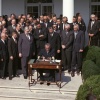The United States and Mexico renegotiated the terms of their free trade agreement, President Donald Trump announced this week, replacing NAFTA with something he dubbed the “U.S.-Mexico Trade Agreement.” Here are the facts you need to know.
Why did the U.S. negotiate a new trade agreement with Mexico?
President Trump promised to renegotiate NAFTA during the 2016 presidential campaign, seeking more favorable terms for the U.S. auto industry and manufacturing sector. As of this writing, Canada has not agreed to the terms of the free trade agreement (FTA). Trump has renamed NAFTA – which he says has a negative connotation – the “U.S.-Mexico Trade Agreement.”
What are the main differences between this agreement and NAFTA?
First, as of this time the trade agreement is lacking both Canada and the word “free.”
The most consequential differences are designed to enhance U.S. manufacturing.
The agreement increases the mandatory amount of auto content that has to be made in the NAFTA region (or, as this agreement stands, the U.S. and Mexico), from 62.5 percent to 75 percent. That could nudge some auto manufacturing plants to relocate from China to Mexico, an unnamed White House official told Reuters.
The agreement also requires that 40 to 45 percent of all auto content be made by workers earning at least $16 (U.S.) an hour. That’s three-times as much as Mexico’s minimum wage of 88 pesos.
If passed, the agreement would also grant labor unions greater freedom to organize in Mexico.
What are the good aspects of the proposed agreement?
There are a number of positive improvements over NAFTA, which was negotiated in 1994.
Agriculture: The new agreement eliminates subsidies for agricultural goods that the signatory nations sell to each other and explicitly includes genetically modified foods. (“The text covers all biotechnologies, including new technologies such as gene editing,” a government fact sheet states.)
Intellectual property: It cracks down on the sale of suspected pirated or counterfeit goods and movies – including efforts directed against state-owned businesses.
Finance: The new FTA would remove restrictions on U.S. financial service providers, causing Mexico to treat them the same as domestic ones.
Technology: The new agreement makes it easier to store and trade data, including e-books and music, online. It also eases online transactions and enhances privacy safeguards, “including for privacy and unsolicited communications.” U.S. banks have sought reforms in this sector for some time.
Small business: The agreement doubles the de minimis shipment value that a U.S. firm can ship tariff- and custom-free to Mexico, from $50 to $100 (U.S.). “Increasing the de minimis level with a key trading partner like Mexico is a critical outcome for United States small- and medium-sized enterprises (SMEs),” a government fact sheet states. “These SMEs often lack resources to pay customs duties and taxes, and bear the increased compliance costs that low, trade-restrictive de minimis levels place on lower-value shipments, which SMEs often have due to their smaller trade volumes.” This reduces the cost of trade to SMEs and increases the funds available for commerce and investment.
What are the potential pitfalls of this agreement?
The new auto requirements will increase production costs and, thus, the cost of automobiles. The U.S. Trade Representative acknowledges its goal is “to drive higher wages by requiring that 40-45 percent of auto content be made by workers earning at least $16 USD per hour.” (Emphasis added.) The content requirements will also raise the cost of auto parts, which can be manufactured for less money outside the NAFTA area.
Some accounts of the trade agreement report that it allows the U.S. to charge higher tariffs on cars built in new factories built in Mexico. This, and raising the cost of labor in Mexico, may draw Mexican manufacturers back to the U.S.
These steps may create higher wages and more jobs in one niche of the economy: the U.S. auto and manufacturing sector. However, they will come at the expense of everyone purchasing a vehicle.
“The bottom line here is the agreement would increase production costs, and that would increase costs for consumers,” Michelle Casario, an assistant professor of economics at Villanova University, told CBS News.
The burden will fall disproportionately on the poor, who will be priced out of the market for a new car. However, since demand for used cars will increase, so will their price tag.
Did NAFTA undermine U.S. manufacturing?
The total number of Americans that worked in manufacturing actually increased slightly between 1993 and 2000, when China joined the World Trade Organization (WTO). Fewer Americans worked in manufacturing in 2010 than at any time in the postwar era.
If ratified, how long will this agreement last?
The Trump administration wanted a “sunset clause,” causing the treaty to be renegotiated automatically after a defined period. Instead, the treaty will be reviewed every six years. If the parties cannot agree to maintain the agreement, the FTA will expire 10 years after that date. So, the shortest period of time it could hold would be 16 years.
Will Canada join this agreement?
Canada has until Friday to sign onto the agreement. While the government’s indications have largely been positive, Canadian Prime Minister Justin Trudeau has also said, “No deal is better than a bad deal.”
What happens to Canada if it does not sign on?
“If we can't get a good strong fair deal with Canada ... the U.S. might have to resort to auto tariffs” against our northern neighbor, economic adviser Larry Kudlow said on Monday. Those tariffs could reach as high as 25 percent, significantly raising the prices of vehicles imported from Canada.
Some speculate that Canadian abstention could thwart the agreement on procedural grounds. Congress could argue that a bilateral free-trade agreement deal violates the Trade Promotion Authority it granted Trump to renegotiate NAFTA, a trilateral FTA.
What happens to the United States if the agreement falls through?
Estimated job losses have ranged from 300,000 if NAFTA is revoked without a replacement, to 1.8 million, if former trade partners place tariffs on U.S. goods. However, those estimates forecast the complete repeal of NAFTA, not a new FTA involving two of the members. U.S.-Mexico trade totaled an estimated $615.9 billion in 2017.
What happens next?
Canada responds. Donald Trump appears to be content with the concessions he has won from allies in NAFTA, as well as the EU. He appears to want to put the trade war in the past, so the West can present a united front when it confronts China over its trade practices.
Why should Christians care?
Christians should wish for their societies, and those of our allies, to enjoy thriving economies that achieve maximum productivity and employment. Reducing trade barriers and granting greater access to markets across-the-board facilitates this goal and lowers prices, easing the burden on those who are less well-off. Finally, a robust trade agreement helps solidify good international relations, helping all people to live in peace and prosperity.














